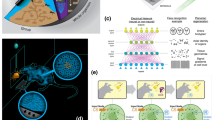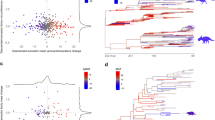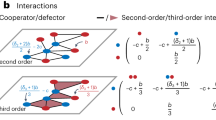Abstract
May’s stability theory, which holds that large ecosystems can be stable up to a critical level of complexity, a product of the number of resident species and the intensity of their interactions, has been a central paradigm in theoretical ecology. So far, however, empirically demonstrating this theory in real ecological systems has been a long-standing challenge with inconsistent results. Especially, it is unknown whether this theory is pertinent in the rich and complex communities of natural microbiomes, mainly due to the challenge of reliably reconstructing such large ecological interaction networks. Here we introduce a computational framework for estimating an ecosystem’s complexity without relying on a priori knowledge of its underlying interaction network. By applying this method to human-associated microbial communities from different body sites and sponge-associated microbial communities from different geographical locations, we found that in both cases the communities display a pronounced trade-off between the number of species and their effective connectance. These results suggest that natural microbiomes are shaped by stability constraints, which limit their complexity.
This is a preview of subscription content, access via your institution
Access options
Access Nature and 54 other Nature Portfolio journals
Get Nature+, our best-value online-access subscription
$29.99 / 30 days
cancel any time
Subscribe to this journal
Receive 12 digital issues and online access to articles
$119.00 per year
only $9.92 per issue
Buy this article
- Purchase on Springer Link
- Instant access to full article PDF
Prices may be subject to local taxes which are calculated during checkout




Similar content being viewed by others
Data availability
All the data analysed in this research are publicly and freely available online.
Human Microbiome Project22: https://hmpdacc.org/
Sponge Microbiome Project41: https://qiita.ucsd.edu/study/description/10793
Code availability
All MATLAB codes used in this research are available at: https://github.com/yogev-yonatan/Microbiome-complexity-stability.
References
May, R. M. Will a large complex system be stable? Nature 238, 413–414 (1972).
May, R. M. & Mac Arthur, R. H. Niche overlap as a function of environmental variability. Proc. Natl Acad. Sci. USA 69, 1109–1113 (1972).
May, R. M. Stability and Complexity in Model Ecosystems (Princeton Univ. Press, 2019).
Sinha, S. Complexity vs. stability in small-world networks. Phys. A 346, 147–153 (2005).
Thébault, E. & Fontaine, C. Stability of ecological communities and the architecture of mutualistic and trophic networks. Science 329, 853–856 (2010).
Mougi, A. & Kondoh, M. Diversity of interaction types and ecological community stability. Science 337, 349–351 (2012).
Allesina, S. & Tang, S. Stability criteria for complex ecosystems. Nature 483, 205–208 (2012).
Allesina, S. & Tang, S. The stability–complexity relationship at age 40: a random matrix perspective. Popul. Ecol. 57, 63–75 (2015).
Qian, J. J. & Akçay, E. The balance of interaction types determines the assembly and stability of ecological communities. Nat. Ecol. Evol. 4, 356–365 (2020).
Landi, P., Minoarivelo, H. O., Brännström, Å., Hui, C. & Dieckmann, U. in Systems Analysis Approach for Complex Global Challenges (eds Mensah, P. et al.) 209–248 (Springer, 2018).
Townsend, S. E., Haydon, D. T. & Matthews, L. On the generality of stability–complexity relationships in Lotka–Volterra ecosystems. J. Theor. Biol. 267, 243–251 (2010).
Pimm, S. L., Lawton, J. H. & Cohen, J. E. Food web patterns and their consequences. Nature 350, 669–674 (1991).
Yodzis, P. The stability of real ecosystems. Nature 289, 674–676 (1981).
Winemiller, K. O. Must connectance decrease with species richness? Am. Naturalist 134, 960–968 (1989).
Warren, P. H. Variation in food-web structure: the determinants of connectance. Am. Nat. 136, 689–700 (1990).
de Ruiter, P. C., Neutel, A.-M. & Moore, J. C. Energetics, patterns of interaction strengths, and stability in real ecosystems. Science 269, 1257–1260 (1995).
Schmid-Araya, J. M. et al. Connectance in stream food webs. J. Anim. Ecol. 71, 1056–1062 (2002).
Neutel, A.-M. et al. Reconciling complexity with stability in naturally assembling food webs. Nature 449, 599–602 (2007).
James, A. et al. Constructing random matrices to represent real ecosystems. Am. Nat. 185, 680–692 (2015).
Jacquet, C. et al. No complexity–stability relationship in empirical ecosystems. Nat. Commun. 7, 12573 (2016).
Thompson, L. R. et al. A communal catalogue reveals earth’s multiscale microbial diversity. Nature 551, 457–463 (2017).
Huttenhower, C. et al. Structure, function and diversity of the healthy human microbiome. Nature 486, 207 (2012).
Fricker, A. M., Podlesny, D. & Fricke, W. F. What is new and relevant for sequencing-based microbiome research? A mini-review. J. Adv. Res. 19, 105–112 (2019).
Sander, E. L., Wootton, J. T. & Allesina, S. Ecological network inference from long-term presence-absence data. Sci. Rep. 7, 7154 (2017).
Steinway, S. N., Biggs, M. B., Loughran Jr, T. P., Papin, J. A. & Albert, R. Inference of network dynamics and metabolic interactions in the gut microbiome. PLoS Comput. Biol. 11, e1004338 (2015).
Bucci, V. et al. Mdsine: microbial dynamical systems inference engine for microbiome time-series analyses. Genome Biol. 17, 121 (2016).
Stein, R. R. et al. Ecological modeling from time-series inference: insight into dynamics and stability of intestinal microbiota. PLoS Comput. Biol. 9, e1003388 (2013).
Fisher, C. K. & Mehta, P. Identifying keystone species in the human gut microbiome from metagenomic timeseries using sparse linear regression. PloS ONE 9, e102451 (2014).
Gerber, G. K., Onderdonk, A. B. & Bry, L. Inferring dynamic signatures of microbes in complex host ecosystems. PLoS Comput. Biol. 8, e1002624 (2012).
Cao, H.-T., Gibson, T. E., Bashan, A. & Liu, Y.-Y. Inferring human microbial dynamics from temporal metagenomics data: pitfalls and lessons. BioEssays 39, 1600188 (2017).
David, L. A. et al. Host lifestyle affects human microbiota on daily timescales. Genome Biol. 15, R89 (2014).
Caporaso, J. G. et al. Moving pictures of the human microbiome. Genome Biol. 12, R50 (2011).
Buffie, C. G. et al. Profound alterations of intestinal microbiota following a single dose of clindamycin results in sustained susceptibility to clostridium difficile-induced colitis. Infect. Immun. 80, 62–73 (2012).
Dohlman, A. B. & Shen, X. Mapping the microbial interactome: statistical and experimental approaches for microbiome network inference. Exp. Biol. Med. 244, 445–458 (2019).
Faust, K. & Raes, J. Microbial interactions: from networks to models. Nat. Rev. Microbiol. 10, 538–550 (2012).
Friedman, J. & Alm, E. J. Inferring correlation networks from genomic survey data. PLoS Comput. Biol. 8, e1002687 (2012).
Jiang, D. et al. Microbiome multi-omics network analysis: statistical considerations, limitations, and opportunities. Front. Genet. 10, 995 (2019).
Faust, K. Open challenges for microbial network construction and analysis. ISME J. 15, 3111–3118 (2021).
Bashan, A. et al. Universality of human microbial dynamics. Nature 534, 259–262 (2016).
Vila, J. C., Liu, Y.-Y. & Sanchez, A. Dissimilarity–overlap analysis of replicate enrichment communities. ISME J. 14, 2505–2513 (2020).
Moitinho-Silva, L. et al. The sponge microbiome project. Gigascience 6, gix077 (2017).
Swierts, T., Cleary, D. & de Voogd, N. Prokaryotic communities of Indo-Pacific giant barrel sponges are more strongly influenced by geography than host phylogeny. FEMS Microbiol. Ecol. 94, fiy194 (2018).
Jost, L. Entropy and diversity. Oikos 113, 363–375 (2006).
Suweis, S., Grilli, J., Banavar, J. R., Allesina, S. & Maritan, A. Effect of localization on the stability of mutualistic ecological networks. Nat. Commun. 6, 10179 (2015).
Grilli, J., Barabás, G., Michalska-Smith, M. J. & Allesina, S. Higher-order interactions stabilize dynamics in competitive network models. Nature 548, 210–213 (2017).
Butler, S. & O'Dwyer, J. P. Stability criteria for complex microbial communities. Nat. Commun. 9, 2970 (2018).
Allesina, S. & Grilli, J. in Theoretical Ecology: Concepts and Applications (eds McCann, K. & Gellner, G.) Ch. 6 (Oxford Univ. Press, 2020).
Jayant, P. & Shnerb, N. M. How temporal environmental stochasticity affects species richness: destabilization neutralization and the storage effect. J. Theor. Biol. 539, 111053 (2022).
Faith, J. J. et al. The long-term stability of the human gut microbiota. Science 341, 1237439 (2013).
Gajer, P. et al. Temporal dynamics of the human vaginal microbiota. Sci. Transl. Med. 4, 132ra52–132ra52 (2012).
Van der Maaten, L. & Hinton, G. Visualizing data using t-sne. J. Mach. Learn. Res. 9, 2579–2605 (2008).
Bunin, G. Ecological communities with Lotka-Volterra dynamics. Phys. Rev. E 95, 042414 (2017).
Acknowledgements
We thank D. Vaknin Ben Porath for reviewing the manuscript. A.B. thanks the German-Israeli Foundation for Scientific Research and Development (grant number I-1523-500.15/2021), the Israel Science Foundation (grant number 1258/21) and the Azrieli Foundation for supporting this research.
Author information
Authors and Affiliations
Contributions
A.B. conceived and supervised the project. Y.Y. and G.A. developed the methodology, performed numerical simulations and analysed the real data. Y.Y., G.A., J.F. and A.B. analysed the results. Y.Y., G.A. and A.B. wrote the manuscript. Y.Y., G.A., J.F. and A.B. edited the manuscript.
Corresponding author
Ethics declarations
Competing interests
The authors declare no competing interests.
Peer review
Peer review information
Nature Ecology & Evolution thanks Akshit Goyal and the other, anonymous, reviewer(s) for their contribution to the peer review of this work.
Additional information
Publisher’s note Springer Nature remains neutral with regard to jurisdictional claims in published maps and institutional affiliations.
Supplementary information
Supplementary Information
Supplementary discussion, analytical derivations and Figs. 1–27.
Rights and permissions
About this article
Cite this article
Yonatan, Y., Amit, G., Friedman, J. et al. Complexity–stability trade-off in empirical microbial ecosystems. Nat Ecol Evol 6, 693–700 (2022). https://doi.org/10.1038/s41559-022-01745-8
Received:
Accepted:
Published:
Issue Date:
DOI: https://doi.org/10.1038/s41559-022-01745-8
This article is cited by
-
Evolutionary modeling suggests that addictions may be driven by competition-induced microbiome dysbiosis
Communications Biology (2023)
-
How diverse ecosystems remain stable
Nature Ecology & Evolution (2022)



